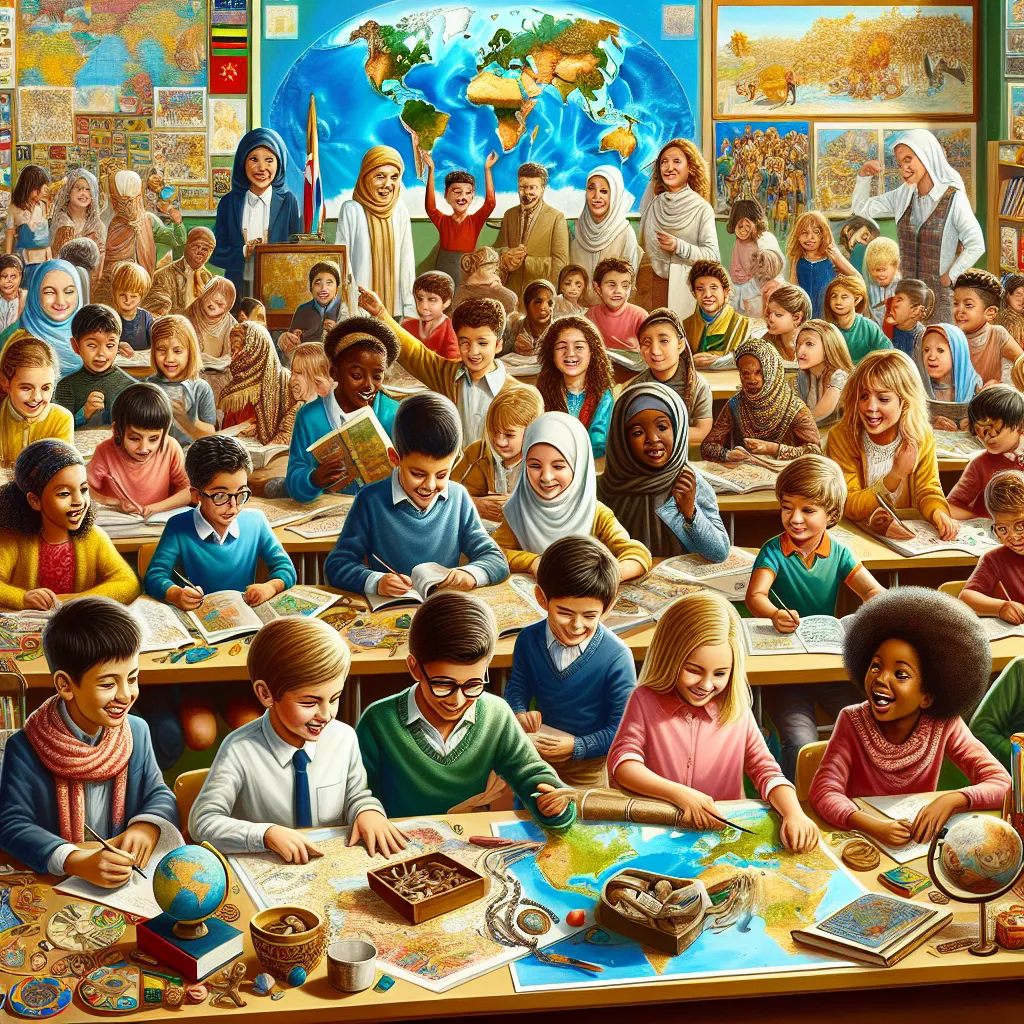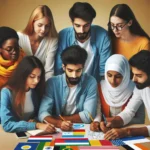In recent years, the topic of promoting cultural understanding through education has gained significant traction in IELTS Writing Task 2 examinations. This theme reflects the growing global emphasis on intercultural competence and diversity in educational settings. Based on trends observed in past IELTS exams and the increasing relevance of this subject in our interconnected world, it’s highly likely that questions related to cultural understanding in education will continue to appear frequently in future tests.
Let’s examine a typical IELTS Writing Task 2 question on this topic:
Some people believe that schools should teach children about different cultures and traditions from around the world. Others think that this is unnecessary and children should focus on their own culture and traditions. Discuss both views and give your own opinion.
Analyzing the Question
This question presents two contrasting viewpoints on the role of cultural education in schools:
- Schools should teach about various global cultures and traditions.
- Schools should focus solely on local culture and traditions.
The task requires you to discuss both perspectives and provide your own opinion. This format is common in IELTS Writing Task 2 and tests your ability to analyze different viewpoints, present balanced arguments, and express your personal stance with supporting reasons.
Sample Essays
Band 8-9 Essay
In today’s increasingly globalized world, the question of whether schools should prioritize teaching about diverse cultures or focus solely on local traditions is a matter of significant debate. While both approaches have their merits, I believe that a balanced curriculum incorporating both global and local cultural education is essential for developing well-rounded individuals.
Those who advocate for teaching about different cultures and traditions from around the world argue that this approach fosters global awareness and prepares students for an interconnected future. By exposing children to diverse perspectives and ways of life, schools can cultivate empathy, tolerance, and cross-cultural communication skills. These competencies are invaluable in our multicultural societies and global workplaces. Moreover, understanding various cultures can broaden students’ horizons, encouraging critical thinking and challenging ethnocentric viewpoints.
On the other hand, proponents of focusing on local culture and traditions contend that this approach is crucial for preserving cultural identity and heritage. They argue that in the face of globalization, it is more important than ever to ensure that young people have a strong foundation in their own cultural roots. This knowledge can provide a sense of belonging and continuity, which is essential for personal and social development. Furthermore, a deep understanding of one’s own culture can serve as a solid basis for appreciating and comparing other cultures.
In my opinion, the most effective approach is to strike a balance between these two perspectives. Schools should aim to provide a comprehensive cultural education that encompasses both local and global elements. By integrating lessons on diverse world cultures with in-depth study of local traditions, educational institutions can equip students with the tools to navigate both their immediate cultural context and the broader global landscape. This balanced approach not only fosters a strong sense of cultural identity but also develops the intercultural competence necessary for success in our diverse world.
Moreover, this integrated method can lead to more nuanced understanding and appreciation of cultures. Students can learn to recognize similarities and differences between their own traditions and those of others, fostering a sense of global unity while respecting cultural diversity. This approach aligns with the concept of “glocalization” – thinking globally while acting locally – which is increasingly relevant in our interconnected yet culturally diverse world.
In conclusion, while arguments exist for both focusing on global cultures and emphasizing local traditions in education, a balanced approach that incorporates both elements is the most beneficial. By providing students with a rich tapestry of cultural knowledge, both local and global, schools can cultivate individuals who are rooted in their own heritage yet open to and understanding of the wider world. This holistic cultural education is crucial for fostering a generation of global citizens who can navigate and contribute positively to our diverse, interconnected society.
(Word count: 446)
Band 6-7 Essay
The question of whether schools should teach about different cultures or focus on local traditions is an important topic in education today. Both viewpoints have their advantages, but I think a mix of both approaches is the best way forward.
Those who support teaching about different cultures say it’s important for children to learn about the world. In our global society, understanding other cultures can help students in their future careers and personal lives. Learning about diverse traditions can make children more open-minded and respectful of others. This knowledge can also help reduce prejudice and discrimination.
On the other hand, people who think schools should focus on local culture argue that it’s crucial for children to know their own heritage. They believe that understanding one’s own culture gives a sense of identity and belonging. This view suggests that if children don’t learn about their own traditions, these might be lost over time. Also, they say that it’s easier to understand other cultures if you have a good grasp of your own.
In my opinion, schools should try to balance both approaches. I think it’s possible and beneficial to teach both local and global cultures. By learning about their own traditions, children can develop a strong sense of identity. At the same time, learning about other cultures can broaden their horizons and prepare them for a diverse world.
This balanced approach can help students appreciate similarities and differences between cultures. For example, they might learn how different cultures celebrate holidays or how family structures vary around the world. This can lead to greater understanding and respect for diversity.
To conclude, while there are arguments for focusing on either global or local cultures in schools, I believe a combination of both is ideal. This approach can help create well-rounded individuals who are proud of their heritage but also open to and understanding of other cultures. In our interconnected world, this kind of education is essential for fostering harmony and mutual respect among different communities.
(Word count: 329)
 Cultural Education Illustration
Cultural Education Illustration
Key Points to Consider When Writing
-
Essay Structure: Both essays follow a clear structure with an introduction, body paragraphs discussing each viewpoint, the writer’s opinion, and a conclusion. The Band 8-9 essay provides more detailed analysis and uses more sophisticated language.
-
Vocabulary: The Band 8-9 essay uses more advanced vocabulary and phrases, such as “ethnocentric viewpoints,” “cultural identity,” and “glocalization.” The Band 6-7 essay uses simpler language but still effectively communicates the main ideas.
-
Coherence and Cohesion: Both essays use appropriate linking words and phrases to connect ideas. The Band 8-9 essay demonstrates more sophisticated cohesion techniques.
-
Argument Development: The Band 8-9 essay provides more in-depth analysis and examples to support its points. The Band 6-7 essay presents clear arguments but with less elaboration.
-
Personal Opinion: Both essays clearly state the writer’s opinion, but the Band 8-9 essay integrates it more smoothly throughout the text.
Important Vocabulary to Remember
-
Cultural diversity (noun) /ˈkʌltʃərəl daɪˈvɜːrsəti/: The existence of different cultures or ethnic groups within a society.
-
Intercultural competence (noun) /ˌɪntərˈkʌltʃərəl ˈkɒmpɪtəns/: The ability to communicate effectively and appropriately with people from other cultures.
-
Ethnocentric (adjective) /ˌeθnəʊˈsentrɪk/: Evaluating other cultures according to preconceptions originating in the standards and customs of one’s own culture.
-
Globalization (noun) /ˌɡləʊbəlaɪˈzeɪʃən/: The process by which businesses or other organizations develop international influence or start operating on an international scale.
-
Heritage (noun) /ˈherɪtɪdʒ/: Valued objects and qualities such as cultural traditions that have been passed down from previous generations.
-
Multiculturalism (noun) /ˌmʌltiˈkʌltʃərəlɪzəm/: The presence of, or support for the presence of, several distinct cultural or ethnic groups within a society.
-
Cross-cultural communication (noun) /krɒs ˈkʌltʃərəl kəˌmjuːnɪˈkeɪʃən/: The process of exchanging, negotiating, and mediating cultural differences through language, gestures, and body language.
-
Cultural identity (noun) /ˈkʌltʃərəl aɪˈdentəti/: The identity or feeling of belonging to a group based on nationality, ethnicity, religion, social class, generation, locality or any kind of social group.
-
Glocalization (noun) /ˌɡləʊkəlaɪˈzeɪʃən/: The adaptation of global influences to local conditions.
-
Cultural literacy (noun) /ˈkʌltʃərəl ˈlɪtərəsi/: The ability to understand and participate fluently in a given culture.
Conclusion
The topic of promoting cultural understanding through education is likely to remain relevant in IELTS Writing Task 2. To prepare, practice writing essays on related themes such as:
- The role of language learning in promoting cultural understanding
- The impact of student exchange programs on cultural awareness
- The influence of technology on cross-cultural communication in education
- The balance between preserving cultural heritage and embracing global culture in school curricula
Remember, the key to success in IELTS Writing Task 2 is practice. Try writing your own essay on the topic discussed in this article and share it in the comments section below. This active practice will help you improve your writing skills and prepare you for success in your IELTS exam.
For more insights on related topics, you might find our articles on how to promote social inclusion in diverse societies and how to manage the impact of economic inequality on education helpful in broadening your perspective on cultural and educational issues.


